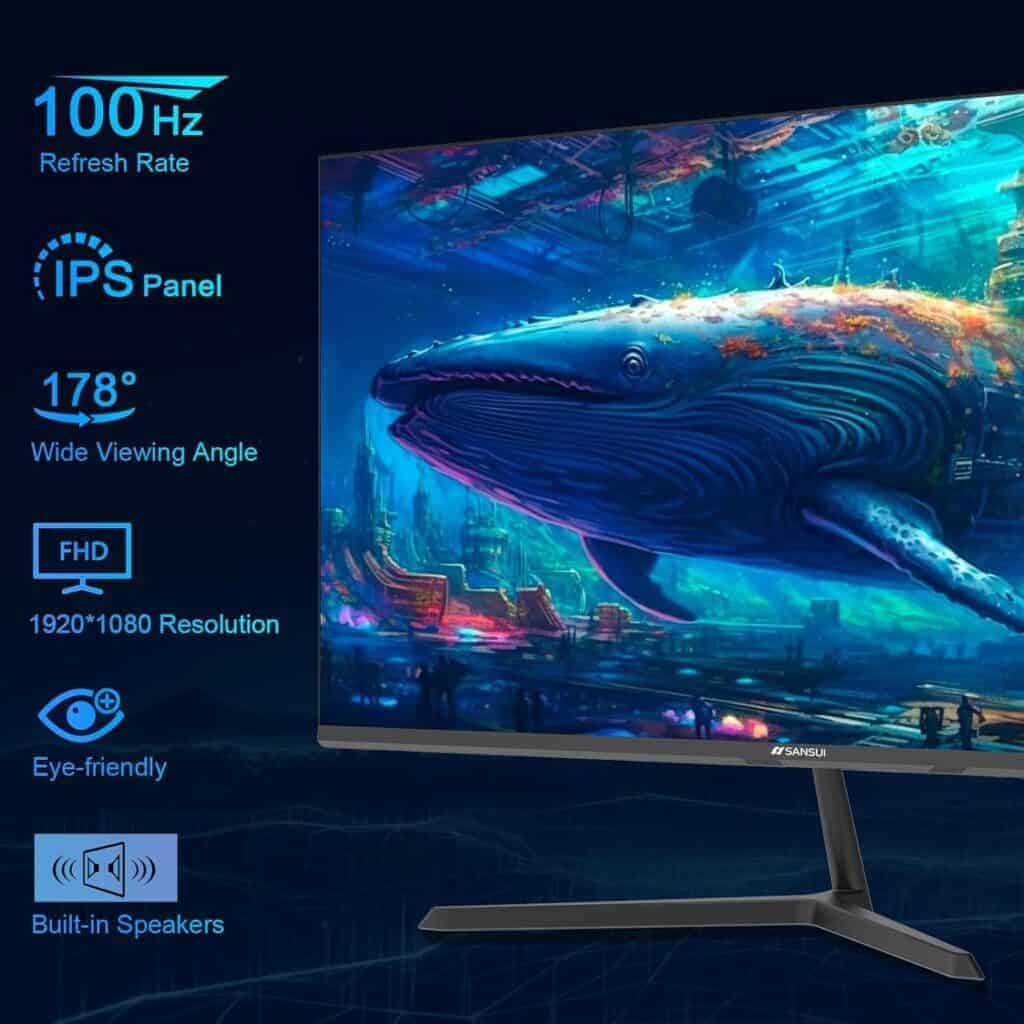A 100Hz refresh rate is great for gaming, providing a noticeable improvement over the standard 60Hz found in many older monitors. You’ll experience smoother motion, reduced motion blur, and improved responsiveness, which makes fast-paced action and competitive games feel more fluid and enjoyable. Whether it’s sufficient for you depends on your gaming preferences and the capabilities of your PC. If you primarily play slower-paced titles or are a casual gamer, 100Hz is likely enough. However, for competitive gamers or those seeking the best visual experience, higher refresh rates like 144Hz or 240Hz can offer an even greater advantage. While 100Hz is a solid choice, exploring higher refresh rate options is worth it if they fit your needs and budget.

Understanding Refresh Rates for Gamers
| Refresh Rate | Good For | Not Ideal For |
|---|---|---|
| 60Hz | Casual gaming, less demanding titles, budget setups | Fast-paced action, competitive gaming, high-end PCs |
| 75Hz | Slight upgrade over 60Hz, budget-friendly option | Demanding games, competitive gaming, high-end PCs |
| 100Hz | Casual to mid-range gaming, noticeable improvement over 60Hz | High-end competitive gaming, top-tier PCs |
| 120Hz | Smooth and responsive, good for most gamers | Extremely fast-paced games, esports professionals |
| 144Hz | Excellent for fast-paced games, popular choice for gamers | Very high-end setups, diminishing returns for some |
| 165Hz | Further improvement over 144Hz, suitable for competitive gaming | High cost, requires powerful PC |
| 240Hz+ | Ultimate smoothness, ideal for esports and competitive gaming | Very expensive, requires top-tier PC, diminishing returns for casual gamers |
How Refresh Rate Impacts Gaming
A 100Hz refresh rate means your monitor can display 100 frames per second (fps). This is double the 50fps of a standard TV, leading to a smoother, more fluid visual experience. The higher the refresh rate, the smoother the motion appears on screen. This is especially important for competitive gamers who need to react quickly to what’s happening on screen.
100Hz vs. Higher Refresh Rates
While 100Hz is a significant improvement over 60Hz, higher refresh rates like 144Hz or even 240Hz can offer even smoother gameplay. However, to take full advantage of these higher refresh rates, your computer needs to be powerful enough to consistently deliver that many frames per second in your games.
| Refresh Rate | Benefits | Who It’s For |
|---|---|---|
| 100Hz | Noticeable improvement over 60Hz, smoother motion, good for most gamers | Casual and competitive gamers who want smoother gameplay |
| 144Hz | Even smoother than 100Hz, competitive edge in fast-paced games | Competitive gamers and those with powerful PCs |
| 240Hz | Smoothest possible experience, ideal for esports professionals | Hardcore competitive gamers and esports professionals |
Choosing the Right Refresh Rate
The best refresh rate for you depends on your budget, gaming habits, and the capabilities of your PC. If you have a powerful gaming rig and play competitive games, a higher refresh rate like 144Hz or 240Hz is worth considering. But for most gamers, 100Hz offers a significant improvement over 60Hz and is a good balance of performance and affordability.
Additional Factors to Consider
Refresh rate isn’t the only factor affecting your gaming experience. Response time, panel type, and color accuracy also play important roles. Make sure to research and choose a monitor that meets your specific needs and preferences.

Pros & Cons
A 100Hz refresh rate monitor can be a good option for gaming, but it’s not the ideal choice for everyone. Here’s a breakdown of the pros and cons to help you decide:
Pros:
- Smoother visuals: Compared to the standard 60Hz, a 100Hz refresh rate delivers noticeably smoother animations and gameplay, reducing motion blur and ghosting. This can be especially beneficial in fast-paced games like shooters and racing titles.
- Competitive edge: In games where every millisecond counts, a 100Hz refresh rate can give you a slight edge over players using 60Hz monitors. You’ll be able to react faster to on-screen movements and enemies.
- More immersive experience: A higher refresh rate makes the game world feel more responsive and fluid, leading to a more immersive gaming experience.

Cons:
- Not as smooth as higher refresh rates: While noticeably smoother than 60Hz, 100Hz falls short of the buttery smoothness of 144Hz and above. If you’re used to high refresh rates, 100Hz might feel slightly sluggish.
- Requires a decent graphics card: To fully utilize a 100Hz monitor, you need a graphics card that can consistently push frame rates above 100 FPS. Otherwise, you’ll experience screen tearing and stuttering.
- Pricier than 60Hz monitors: 100Hz monitors generally cost more than their 60Hz counterparts. However, they’re also often cheaper than higher refresh rate options like 144Hz.
Here’s a quick summary:
| Recommendation | Scenario |
|---|---|
| Good | Casual gamers who want a smoother experience than 60Hz but don’t need the bleeding-edge performance of 144Hz and above |
| Might be good | Competitive gamers who primarily play slower-paced esports titles like MOBAs or strategy games |
| Not ideal | Hardcore competitive gamers who play fast-paced shooters and require the absolute smoothest visuals |
Ultimately, the decision of whether 100Hz is good for you depends on your individual needs and budget. If you’re looking for a noticeable upgrade over 60Hz without breaking the bank, a 100Hz monitor can be a great option. Just make sure you have a compatible graphics card to get the most out of it.
Key Takeaways
- Smoother Gameplay: 144Hz monitors offer smoother gameplay compared to 100Hz, but the difference may not be easily noticeable.
- Input Lag: Higher refresh rates like 144Hz can reduce input lag, providing a more responsive gaming experience.
- Budget Considerations: 100Hz monitors are generally more affordable than 144Hz models.
- GPU Compatibility: 144Hz monitors might require more modern GPUs for optimal performance.

Understanding Refresh Rates: 100Hz vs. 144Hz
The refresh rate, measured in Hz, indicates how many times a monitor refreshes the displayed image per second. A higher refresh rate can lead to smoother gameplay and reduced motion blur, enhancing the gaming experience. However, the perceptible difference between 100Hz and 144Hz might not be significant for casual gamers, though competitive players might prefer the latter for its slight edge in smoothness and responsiveness.
Input Lag and Gaming Performance
- 100Hz Monitors: Suitable for general gaming; offers a decent balance between performance and cost.
- 144Hz Monitors: Ideal for competitive gaming; provides smoother transitions and lower input lag.
Budget and Price Range
- 100Hz Options: More budget-friendly, offering a good balance for casual or non-competitive gaming.
- 144Hz Models: Slightly more expensive, often featuring additional high-end specs like better response times and higher resolutions.
Real-World Gamer Insights
Reddit discussions and user experiences highlight the nuanced differences between 100Hz and 144Hz monitors. Many users transitioning from 60Hz to 100Hz notice a significant improvement in smoothness, but the jump from 100Hz to 144Hz is less pronounced. For instance, a Reddit user playing FPS games mentioned that while the upgrade from 60Hz to 144Hz was visibly smoother, they didn’t feel a substantial difference in their gaming performance.

Practical Scenarios
- Casual Gaming: A 100Hz monitor is more than adequate, offering a noticeable improvement over standard 60Hz displays without breaking the bank.
- Competitive Gaming: For games where every millisecond counts, like fast-paced shooters or esports titles, a 144Hz monitor could provide that slight competitive edge.
Technological Considerations
Modern gaming monitors come with technologies like NVIDIA G-Sync or AMD FreeSync, which synchronize the display’s refresh rate with the GPU’s output, further smoothing out the gaming experience. This synchronization can make differences between refresh rates less noticeable.

The Verdict
For most gamers, especially those not engaged in high-level competitive gaming, a 100Hz monitor offers a significant improvement over standard displays and is a cost-effective choice. However, for those seeking every possible advantage in fast-paced games, the extra investment in a 144Hz monitor could be worthwhile.
FAQs
Is a 100Hz monitor good enough for gaming?
Yes, a 100Hz monitor is a decent option for gaming, offering a noticeable improvement in smoothness and responsiveness compared to a standard 60Hz display. It’s suitable for casual gamers and those who play less demanding games. However, for fast-paced competitive games or if you have a powerful PC capable of pushing high frame rates, you might benefit from a higher refresh rate monitor, such as 144Hz or 240Hz.
Is 60Hz better than 120Hz for gaming?
No, 120Hz is significantly better than 60Hz for gaming. A 120Hz monitor displays twice as many frames per second, resulting in smoother motion, reduced motion blur, and improved responsiveness. The difference is particularly noticeable in fast-paced action games or esports titles where quick reflexes and precise aiming are crucial.
Is 144Hz good for gaming?
Yes, 144Hz is considered a very good refresh rate for gaming, providing a smooth and fluid experience, especially for fast-paced games. It’s a popular choice among gamers and offers a noticeable upgrade over 60Hz and even 120Hz monitors.
Is 120 Hz good enough for gaming?
Yes, 120Hz is generally considered good enough for most gamers, offering a significant improvement in smoothness and responsiveness compared to 60Hz. While 144Hz or higher refresh rates can provide an even better experience, 120Hz is a good balance of performance and affordability.
Is 144Hz better than 120Hz for gaming?
Yes, 144Hz is better than 120Hz for gaming, as it offers an even smoother and more responsive experience. The difference might be subtle for some, but for competitive gamers or those who are particularly sensitive to motion blur, the extra 24 frames per second can make a noticeable difference.
Is 120 to 144 noticeable?
The difference between 120Hz and 144Hz is noticeable, but it might be less dramatic than the jump from 60Hz to 120Hz. You’ll likely perceive smoother motion and reduced motion blur, especially in fast-paced action sequences. However, the extent to which you notice the difference will depend on your individual sensitivity and the type of games you play.
Is 144Hz vs 240Hz noticeable?
Yes, the difference between 144Hz and 240Hz is noticeable, particularly in fast-paced games and for those with sharp eyes. The higher refresh rate of 240Hz provides an even smoother and more responsive experience, with reduced motion blur and improved clarity. However, 240Hz monitors are generally more expensive and require a powerful PC to achieve such high frame rates.
Do I need a 144Hz monitor for competitive gaming?
While a 144Hz monitor is not strictly necessary for competitive gaming, it can provide a competitive advantage. The smoother visuals and reduced input lag can help you react faster and make more precise movements, potentially giving you an edge over opponents using lower refresh rate monitors.
Can I use a 100Hz monitor for professional gaming?
While some professional gamers might use 100Hz monitors, the majority prefer higher refresh rates like 144Hz or 240Hz for the competitive advantages they offer. However, if you’re just starting or playing at a casual level, a 100Hz monitor can still provide a good gaming experience.
Will I notice the difference between 100Hz and 144Hz?
Yes, you’re likely to notice the difference between 100Hz and 144Hz, particularly in fast-paced action games or if you’re sensitive to motion blur. The higher refresh rate of 144Hz will result in smoother visuals and a more responsive feel, making the gaming experience more immersive and enjoyable.
Does a higher refresh rate affect gaming performance?
No, a higher refresh rate itself does not directly affect gaming performance. However, to take full advantage of a higher refresh rate monitor, your PC needs to be capable of rendering frames at a matching or higher rate. This means you might need a more powerful GPU to achieve high frame rates on a 144Hz or 240Hz monitor.







